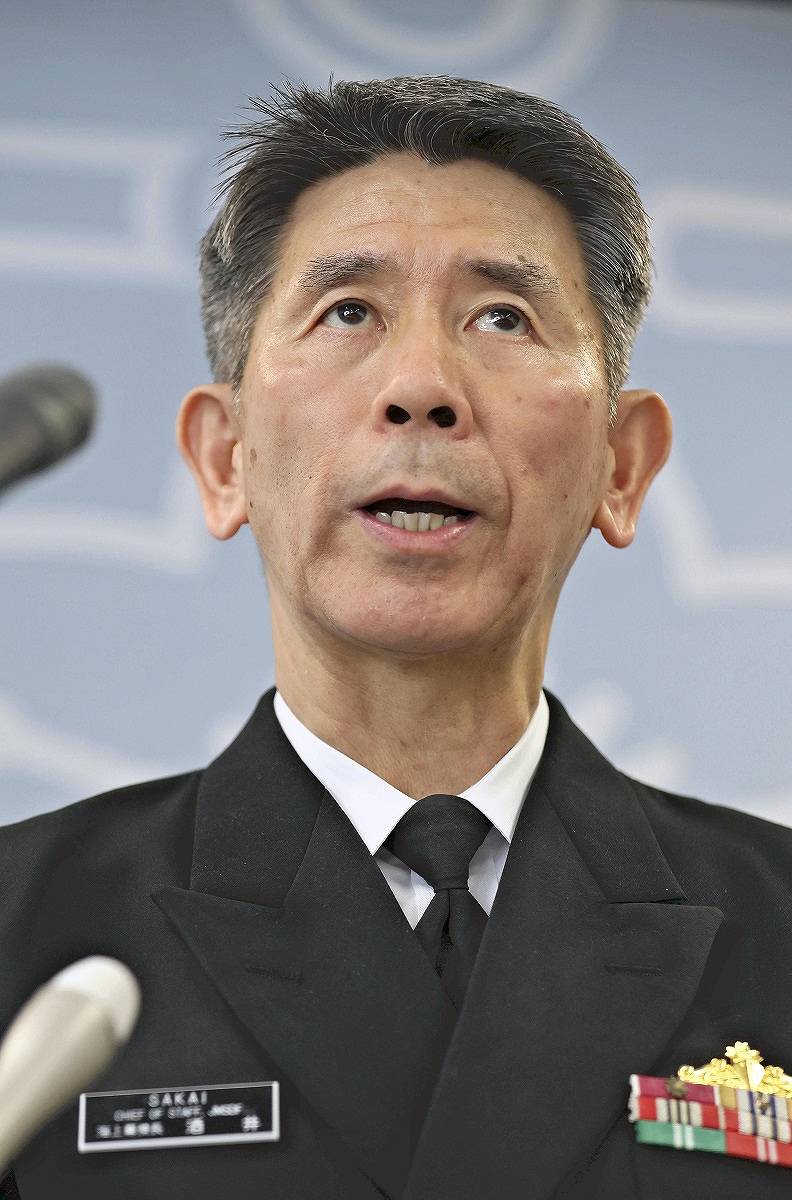Japanese Self-Defense Forces’ Nighttime Helicopter Accident Hearkens Back to Others in 2017, 2021

MSDF Chief of Staff Adm. Ryo Sakai speaks about the helicopter accident, at a press conference in the Defense Ministry on Sunday.
17:18 JST, April 22, 2024
Two Maritime Self-Defense Force patrol helicopters that crashed into the sea east of Tokyo’s Izu island chain were participating in a nighttime submarine detection drill.
Helicopter pilots and crew members taking part in nighttime drills are required to be highly skilled and experienced.
Accidents involving MSDF patrol helicopters during nighttime drills also occurred in 2017 and 2021. Therefore, questions exist over why lessons from past accidents could not be utilized to prevent a recurrence.
The focus of the investigation into the cause of Saturday’s accident is to identify how the two helicopters were flying.
Low visibility
“Visibility levels are low during nighttime drills, and so the operations are quite difficult,” MSDF Chief of Staff Adm. Ryo Sakai said at a quickly set up press conference held Sunday in the wake of the accident. “It’s possible for the distances between helicopters to become quite close when searching for submarines,” said the MSDF’s top officer.
According to the MSDF, the drill was a simulation in which the helicopters took off from surface combat ships, searched for a submarine using sonar devices and then were to attack the submarine. The series of actions undertaken would be confirmed in the drill.
When a maritime patrol helicopter lowers a sonar device into the water, it decreases altitude to about 20 meters above the sea surface and then hovers.
After collecting data at the site, the helicopter ascends to about 50 meters above the sea and moves to another location.
If three helicopters are deployed, they maintain a triangular formation surrounding a target submarine at the center of the triangle and chase it.
Three helicopters were deployed in the area at the time of the accident, including the two that crashed.
To prevent collisions during night drills, pilots and other crew members of patrol helicopters confirm each other’s positions by monitoring radar, wireless radio contact and seeing other helicopters’ lights.
“During flight, each helicopter changes its altitude from those of other friendly aircraft, but pilots and other crew members should be able to identify the positions of those aircraft by radar and other means,” said Bonji Ohara, a senior fellow of the Sasakawa Peace Foundation who was formerly an MSDF helicopter pilot. “It’s difficult to assume that such an accident would occur in usual conditions.”
Altitude and distance
An MSDF patrol helicopter participating in night drills crashed into the sea off Aomori Prefecture in 2017 due to a controlling piloting mistake. Two died and one went missing in the accident.
In 2021, two patrol helicopters were involved in a minor collision over the sea off Kagoshima Prefecture. Although nobody died, the MSDF had to consider measures to prevent a recurrence.
As measures to secure safety when two or more aircraft fly simultaneously, the MSDF instructed personnel that those in charge of flight controls should instruct each of the aircraft to fly at different altitudes, and that pilots should be careful about the distances from other aircraft if there is a possibility that two or more may get very close.
At the press conference on Sunday, Sakai presented items to possibly focus on in the investigation into the cause of the accident. He cited such probe points as whether the two crashed helicopters were flying at different altitudes, whether they kept a sufficient distance from each other and whether crew members properly monitored areas.
The MSDF has recovered from the accident site the flight data recorders that recorded the movements of the helicopters, and it is going to check details of developments of the situation in which the two helicopters got closer.
Flights suspended
The MSDF repeatedly conducts submarine detection drills regardless of whether such exercises are done during the daytime or nighttime.
It does so because extremely high skill levels are needed to detect submarines, which are difficult to find as they hide in vast waters and their whereabouts are hard to pin down.
However, in the wake of the recent accident, the Self-Defense Forces will suspend all flights of the same model of patrol helicopters as those involved in the accident, for the time being.
Sakai said, “As this kind of drill is suspended, I think there will be some impact.” In addition, he announced that the MSDF canceled a plan to participate in the Western Pacific Naval Symposium to be held in Shandong Province, China. The WPNS is an international conference that navy officers of various countries attend.
The accident has negatively affected the SDF’s exchanges with other countries’ defense officials.
"Politics" POPULAR ARTICLE
-

Japan to Support Central Asian Logistics Route That Bypasses Russia, Plan to Be Part of Upcoming Summit in Tokyo
-

Japan to Tighten Screening of Foreigners’ Residential Status by Providing Information of Nonpayment of Taxes
-

Chinese, Russian Bombers Flew Unusual Path by Heading Toward Tokyo; Move Likely Meant to Intimidate Japan
-

Japan Plans National Database to Track Foreign Ownership of Real Estate, Land as It Weighs New Rules
-

Up to 199,000 Deaths Estimated From Mega-Tsunami; Most Recent Occurrence Took Place in 17th Century
JN ACCESS RANKING
-

Tokyo Economic Security Forum to Hold Inaugural Meeting Amid Tense Global Environment
-

Keidanren Chairman Yoshinobu Tsutsui Visits Kashiwazaki-Kariwa Nuclear Power Plant; Inspects New Emergency Safety System
-

Imports of Rare Earths from China Facing Delays, May Be Caused by Deterioration of Japan-China Relations
-

University of Tokyo Professor Discusses Japanese Economic Security in Interview Ahead of Forum
-

Japan Pulls out of Vietnam Nuclear Project, Complicating Hanoi’s Power Plans






















